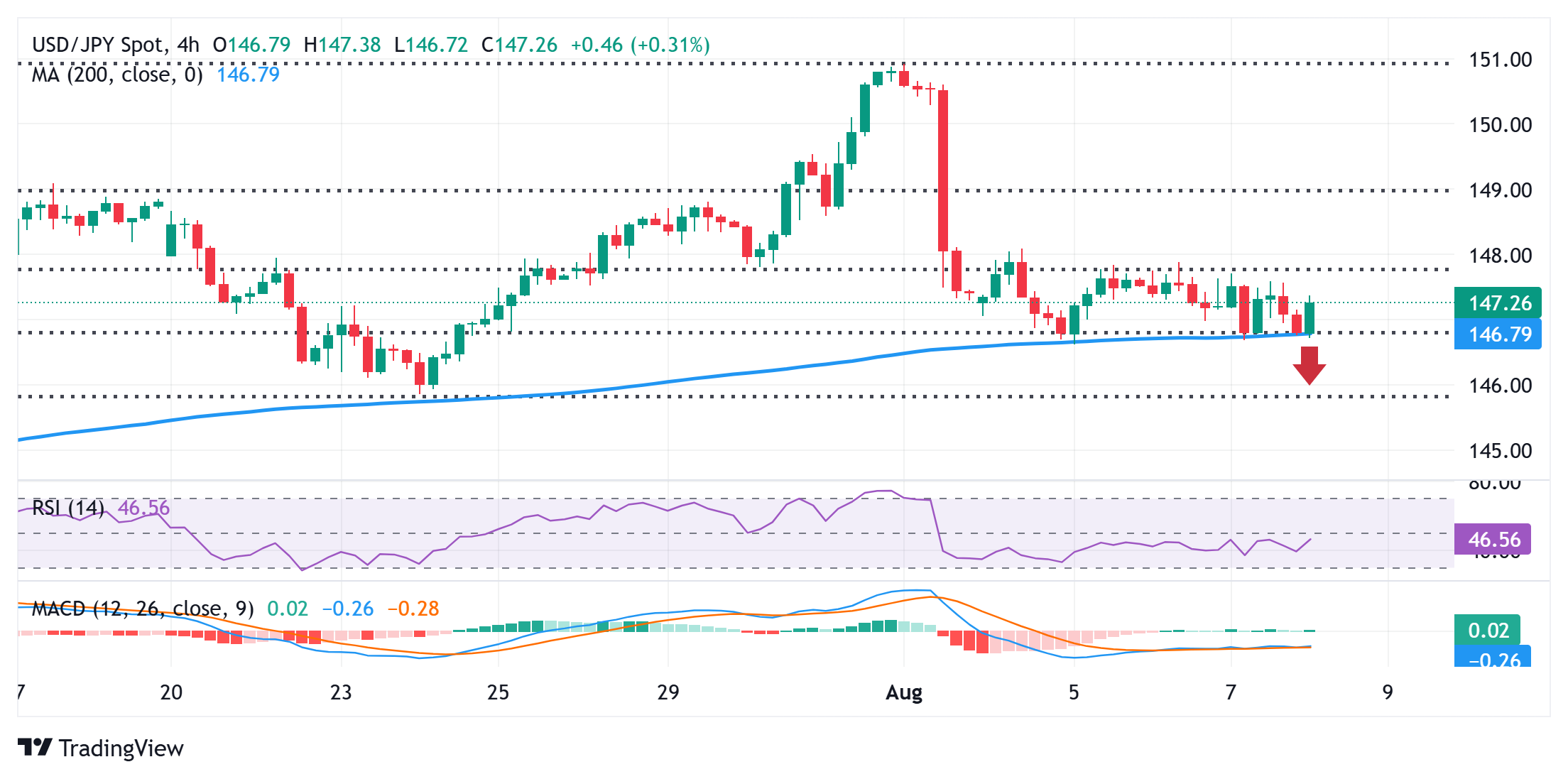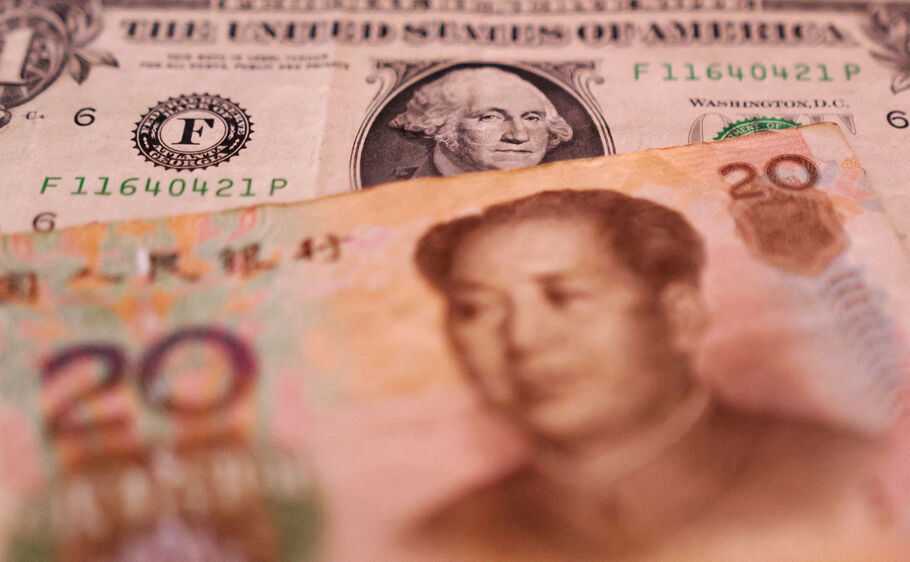Japanese Yen drifts lower against rebounding USD; downside potential seems limited

- The Japanese Yen meets with a fresh supply during the Asian session amid mixed BoJ rate hike cues.
- A positive risk tone further undermines the safe-haven JPY, though the downside seems cushioned.
- Rising Fed rate cut bets should cap any USD recovery and contribute to capping the USD/JPY pair.
The Japanese Yen (JPY) attracts some intraday sellers after the Summary of Opinions from the Bank of Japan's (BoJ) July meeting showed that policymakers remain worried about the potential negative impact of higher US tariffs on the domestic economy. This adds to the uncertainty over the likely timing of the next BoJ rate hike. Furthermore, a generally positive risk tone is seen undermining the safe-haven JPY, which, in turn, assists the USD/JPY pair to once again bounce off the 146.70 support zone during the Asian session on Friday.
Investors, however, seem convinced that the BoJ will raise interest rates by the year-end. In contrast, traders now see a greater chance that the US Federal Reserve (Fed) will lower borrowing costs at the September policy meeting. This, in turn, should keep a lid on any meaningful US Dollar (USD) recovery from a two-week low touched on Thursday and help limit deeper losses for the lower-yielding JPY. Hence, it will be prudent to wait for strong follow-through buying before confirming that the USD/JPY pair has bottomed out in the near term.
Japanese Yen drifts lower as BoJ Summary of Opinions tempers bets for an immediate rate hike
- The Bank of Japan published the Summary of Opinions of its July 30-31 meeting earlier this Friday, which showed that board members maintained their view for further interest-rate increases despite high uncertainty over tariffs. The summary further revealed that Japan's economic growth will moderate, and the improvement in underlying inflation will be sluggish temporarily.
- Earlier, the Ministry of Internal Affairs and Communications reported that Japan's Household Spending rose in June at a slower rate than expected as higher prices added pressure to broader consumption trends. Consumer spending fell 5.2% on a monthly basis, marking the steepest decline since January 2021, suggesting that prospects for BoJ rate hikes could be delayed further.
- Japan's Topix index rose above the 3000 psychological mark for the first time ever, while the tech-focused Nikkei 225 rallied to its highest since July 25. This, in turn, prompts some selling around traditional safe-haven assets, including the Japanese Yen. Apart from this, a modest US Dollar recovery assists the USD/JPY pair to rebound around 60-70 pips from the Asian session low.
- Any meaningful USD appreciation, however, seems elusive amid bets that the Federal Reserve will resume its rate-cutting cycle in September. The expectations were reaffirmed by the US Weekly Initial Jobless Claims data released on Thursday, which rose more than expected last week to the highest level in a month. This further pointed to signs of a cooling US labor market.
- Moreover, concerns about the Fed's independence might contribute to capping gains for the USD and the USD/JPY pair. Meanwhile, US President Donald Trump nominated Council of Economic Advisers Chairman Stephen Miran to serve out the rest of Fed Governor Adriana Kugler's term and has short-listed four candidates as replacements for Fed Chair Jerome Powell.
- Moving ahead, there isn't any relevant market-moving economic data due for release from the US on Friday, leaving the USD at the mercy of speeches from influential FOMC members. Apart from this, the broader risk sentiment could provide some impetus heading into the weekend. Nevertheless, the mixed fundamental backdrop warrants caution for aggressive USD/JPY traders.
USD/JPY might continue to face a strong barrier near 38.2% Fibo., around the 147.75-147.80 region

From a technical perspective, spot prices remain confined in the weekly trading band. Against the backdrop of last week's sharp pullback from the 151.00 neighborhood, or the highest level since March 28, the range-bound price action might still be categorized as a bearish consolidation phase. Moreover, slightly negative oscillators on the daily chart suggest that the path of least resistance for the USD/JPY pair is to the downside.
Hence, any further move up might continue to attract fresh sellers and remain capped near the 147.75-147.80 region, representing the 38.2% Fibonacci retracement level of the upswing in July. That said, some follow-through buying, leading to a subsequent strength beyond the 148.00 mark, could lift the USD/JPY pair to the 148.45-148.50 region. The momentum could extend further towards the 23.6% Fibo. retracement level, just ahead of the 149.00 mark.
On the flip side, the 146.75-146.70 confluence – comprising the 200-period Simple Moving Average (SMA) on the 4-hour and the 50% Fibo. retracement level – might continue to protect the immediate downside. A convincing break below should pave the way for deeper losses and drag the USD/JPY pair to sub-146.00 levels, or the 61.8% Fibo. retracement level. Some follow-through selling below the latter could expose the 145.00 psychological mark.
Bank of Japan FAQs
The Bank of Japan (BoJ) is the Japanese central bank, which sets monetary policy in the country. Its mandate is to issue banknotes and carry out currency and monetary control to ensure price stability, which means an inflation target of around 2%.
The Bank of Japan embarked in an ultra-loose monetary policy in 2013 in order to stimulate the economy and fuel inflation amid a low-inflationary environment. The bank’s policy is based on Quantitative and Qualitative Easing (QQE), or printing notes to buy assets such as government or corporate bonds to provide liquidity. In 2016, the bank doubled down on its strategy and further loosened policy by first introducing negative interest rates and then directly controlling the yield of its 10-year government bonds. In March 2024, the BoJ lifted interest rates, effectively retreating from the ultra-loose monetary policy stance.
The Bank’s massive stimulus caused the Yen to depreciate against its main currency peers. This process exacerbated in 2022 and 2023 due to an increasing policy divergence between the Bank of Japan and other main central banks, which opted to increase interest rates sharply to fight decades-high levels of inflation. The BoJ’s policy led to a widening differential with other currencies, dragging down the value of the Yen. This trend partly reversed in 2024, when the BoJ decided to abandon its ultra-loose policy stance.
A weaker Yen and the spike in global energy prices led to an increase in Japanese inflation, which exceeded the BoJ’s 2% target. The prospect of rising salaries in the country – a key element fuelling inflation – also contributed to the move.






